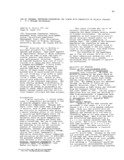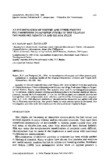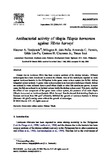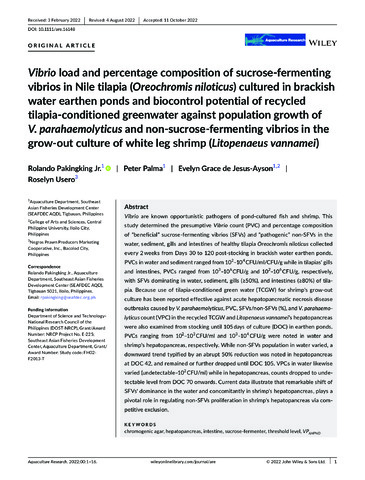Use of internal reference population for growth rate comparison of tilapia strains. I. In a crowded environment
Share
Abstract
This paper reports an experimental design in which reference fish are included in each replicate to provide internal statistical control over environmental variation. Growth of 10 full-sib families from each of 3 strains of Oreochromis niloticus were compared in a crowded environment. A third strain of red tilapia was mass-spawned to provide reference fish. From each family, 25 equal-sized tilapia fry were matched with 25 equal-sized red tilapia fry and reared for 3 weeks in small floating cages inside a bigger tank. Growth of test strains were positively correlated with growth of the reference population. The 3 strains differed significantly in their growth rates. The reference fish technique is useful in experiments in ponds or cages, where variable environmental factors induce positive correlations between reference and test strains.
Subject
Collections
Related items
Showing items related by title, author, creator and subject.
-
An investigation of enzyme and other protein polymorphisms in Japanese stocks of the tilapias Oreochromis niloticus and Tilapia zillii
Basiao, Zubaida U.; Taniguchi, Nobuhiko (Elsevier, 1984)Samples of Oreochromis niloticus and Tilapia zillii were collected from the hatcheries of Osaka Prefecture Fisheries Experimental Station and Shiga Prefecture Fisheries Experimental Station, Japan, respectively. The samples ... -
Antibacterial activity of tilapia Tilapia hornorum against Vibrio harveyi
Tendencia, Eleonor; dela Peña, Milagros R.; Fermin, Armando C.; Lio-Po, Gilda; Choresca, Casiano H., Jr.; Inui, Yasuo (Elsevier, 2004)Disease due to luminous Vibrio has been a major problem of the shrimp industry. Different technologies have been introduced to control the disease. One of the techniques reported to work against luminous bacteria in the ... -
Vibrio load and percentage composition of sucrose‐fermenting vibrios in Nile tilapia (Oreochromis niloticus) cultured in brackish water earthen ponds and biocontrol potential of recycled tilapia‐conditioned greenwater against population growth of V. parahaemolyticus and non‐sucrose‐fermenting vibrios in the grow‐out culture of white leg shrimp (Litopenaeus vannamei)
Pakingking, Rolando V., Jr.; Palma, Peter; de Jesus-Ayson, Evelyn Grace T.; Usero, Roselyn (Wiley, 2022-10-20)Vibrio are known opportunistic pathogens of pond-cultured fish and shrimp. This study determined the presumptive Vibrio count (PVC) and percentage composition of “beneficial” sucrose-fermenting vibrios (SFVs) ...




